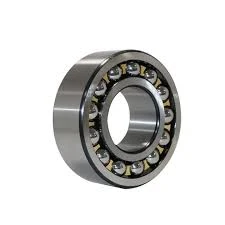
Dec . 04, 2024 10:50 Back to list
Understanding the Definition and Function of Deep Groove Ball Bearings
Understanding Deep Groove Ball Bearings Meaning and Applications
Deep groove ball bearings are among the most utilized bearing types in various industrial applications due to their versatility and efficient design. They are characterized by their simple structure, high load capacity, and ease of installation, making them suitable for a wide range of rotary and reciprocal motion applications.
Definition and Structure
A deep groove ball bearing consists of an inner ring, an outer ring, a cage, and balls. The most distinctive feature of this type of bearing is the deep raceway grooves on both the inner and outer rings. These grooves allow the balls to remain in constant contact with the raceways, which significantly enhances the bearing's ability to handle both radial and axial loads. The deeper the grooves, the higher the contact angle, enabling a greater load-bearing capacity.
Types of Deep Groove Ball Bearings
While deep groove ball bearings come in various sizes and designs, they can be broadly classified into two main categories shielded and sealed. Shielded bearings feature metal shields on both sides, providing a barrier against dust and debris while allowing for some level of grease lubrication. Sealed bearings, on the other hand, have rubber seals that provide enhanced protection against contaminants and are typically pre-lubricated, making them maintenance-free for extended periods.
Applications
Deep groove ball bearings are used in numerous applications across different industries. Their ability to accommodate both axial and radial loads makes them particularly suitable for various mechanical equipment. Common applications include electric motors, automotive components, pumps, fans, and compressors. In the automotive sector, for instance, they are often employed in wheel hubs and transmission systems, playing a critical role in ensuring smooth operation and longevity.
Moreover, deep groove ball bearings are popular in electrical applications, especially in devices that require high-speed operation and minimal friction like high-speed spindles and fans. They also play a crucial role in household appliances, ensuring the efficient functioning of washing machines, refrigerators, and air conditioning units.
deep groove ball bearing meaning

Advantages of Deep Groove Ball Bearings
1. Load Capacity Deep groove ball bearings can support both radial and axial loads, allowing for efficient performance in dynamic conditions.
2. Versatility Their adaptable design makes them suitable for various applications, from industrial machinery to consumer electronics.
3. Low Friction With a simple design that facilitates smooth rolling motion, these bearings exhibit low friction, contributing to energy efficiency and reduced wear.
4. Cost-Effectiveness Compared to other bearing types, deep groove ball bearings tend to be more affordable, making them a popular choice for manufacturers seeking to minimize costs while maintaining quality.
5. Maintenance-Free Options With the availability of sealed bearings pre-lubricated with grease, users can enjoy extended service life without the need for regular maintenance.
Conclusion
Deep groove ball bearings represent a crucial component in mechanical engineering, delivering a combination of efficiency, reliability, and versatility. Their design allows them to excel in various load conditions and applications, from industrial machinery to automotive components and household appliances. As technology continues to advance, the demand for high-performance, low-friction bearings like deep groove ball bearings will likely grow, further solidifying their importance in manufacturing and engineering sectors. Whether you're a manufacturer, engineer, or DIY enthusiast, understanding the significance and functionality of deep groove ball bearings is essential for selecting the right components for your projects and applications.
Latest news
-
Premium Deep Groove Ball Bearings | High Speed & Reliability
NewsAug.29,2025
-
Durable Scaffolding Clamps - Secure & Reliable Tube Connectors
NewsAug.28,2025
-
Common Failures in Thrust Ball Bearings and Solutions
NewsAug.22,2025
-
How Tapered Roller Bearings Can Take Shock Loads
NewsAug.22,2025
-
Angular Bearings in High-Precision Spindles
NewsAug.22,2025
-
The Impact of Misalignment on Cylindrical Roller Bearing Performance
NewsAug.22,2025
